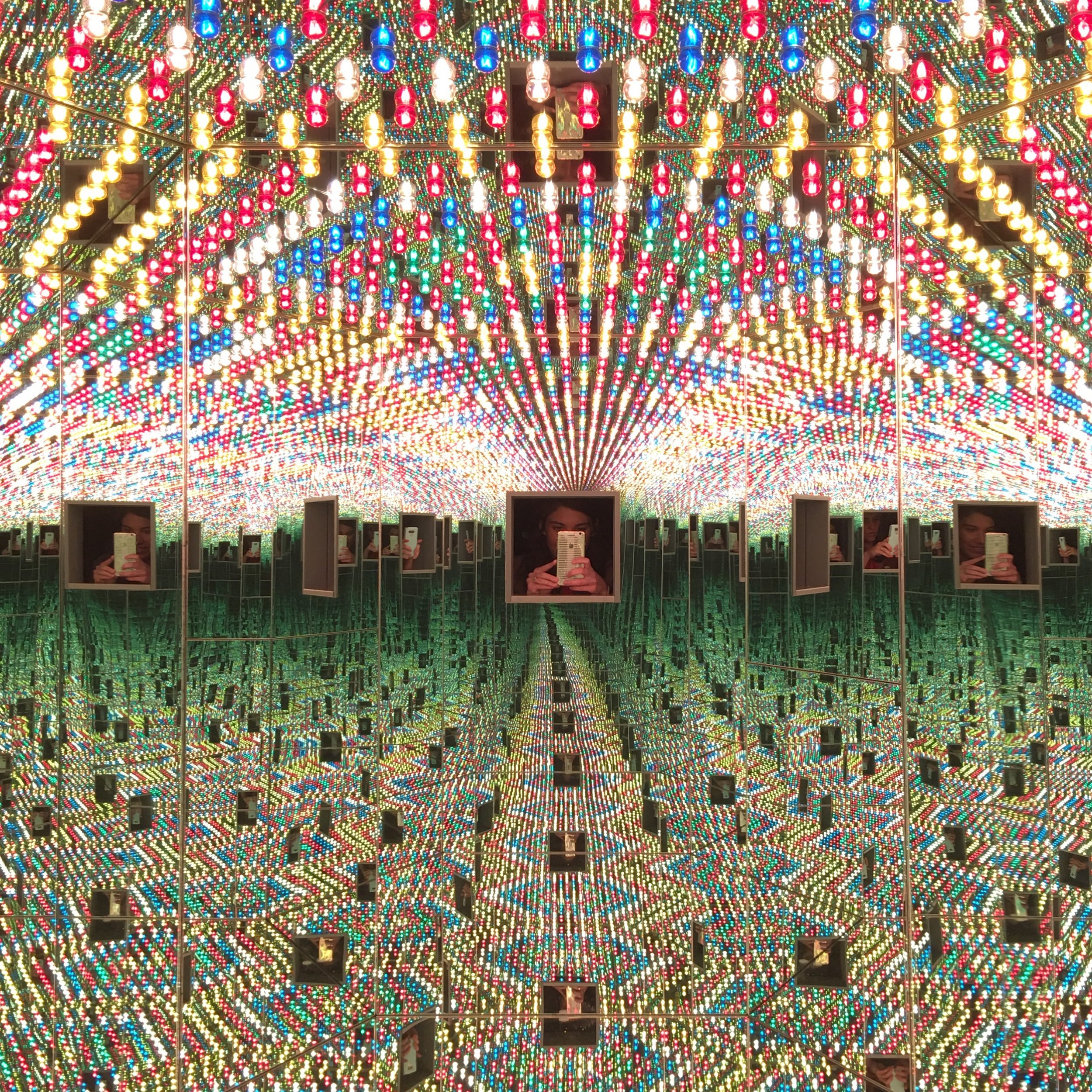a. natasha joukovsky
journal
YAYOI KUSAMA: INFINITY MIRRORS
Kusama's work is innovative and visually stunning, creating illusions of vast magical landscapes inside spaces often the size of a bathroom or closet.
Yayoi Kusama, Infinity Mirrored Room – The Souls of Millions of Light Years Away, 2013
My husband scored timed tickets to the blockbuster exhibition Yayoi Kusama: Infinity Mirrors at the Hirshhorn Museum in Washington last week, and for someone who loves recursion, it did not disappoint.
Kusama's work is innovative and visually stunning, the immersive rooms in particular creating illusions of vast magical landscapes inside spaces often the size of a bathroom or closet.
Yayoi Kusama, Infinity Mirrored Room - Love Forever, 1966/1994
Exterior shot of Infinity Mirrored Room - Love Forever at the Hirshhorn Museum
The individual tableaux range from intergalactic to Alice-in-Wonderland-style weird. My personal favorite, All the Eternal Love I Have for the Pumpkins, which is also Kusama's most recent and on view for the first time at the Hirshhorn, fell somewhere in the middle of this spectrum. This room is a total fusion of recursion, innovation, mythology, and glamour; it felt like stepping into an infinite futuristic fairytale dreamscape.
Yayoi Kusama, All the Eternal Love I have for the Pumpkins, 2016
I'm not surprised Infinity Mirrors has become crushingly popular--popular to the point that one of my friends teased I was "so basic" for going.
For such a photogenic exhibit, photographs don't do it justice. It's interactive and mass-customizable, selfie-friendly, and endlessly Instagrammable. It snuggles perfectly into the sociocultural mores of the moment.
I was fortunate to go on a Wednesday morning when the crowds weren't too bad, but the overall buzz surrounding this exhibition reminds me a lot of the 2011 Alexander McQueen: Savage Beauty mania I experienced intimately when I worked at The Metropolitan Museum of Art. The glamour of the Kusama show has likewise transcended its inherent glamour. The more people wait in line, the more people are willing to wait in line. The line has become part of the attraction, not just a means of getting inside to see.
Here are all of my photos from Yayoi Kusama: Infinity Mirrors:
RECURSION: THE REMIX TO COGNITION
Recursion transcends academic disciplines, unites art and nature, and may be the fundamental linguistic and even cognitive function that differentiates human from animal existence.
The power of recursion, almost by definition, boggles the mind. Its reach transcends academic disciplines, unites art and nature, and may be the fundamental linguistic and even cognitive function that differentiates human from animal existence. Its propensity toward complexity and infinity quickly defies comprehension, with the highest-IQ humans able to process only 6-7 embedded layers. A single infinite loop can crash the most powerful supercomputers, and there's certainly no escape from infinite self-referential nerd jokes.
Broadly, I define recursion as "self-similar embedded repetition." I'm not going to try to rewrite Wikipedia on recursion's many discipline-specific applications and examples, but this list includes:
The Sierpinski Triangle, a fractal
- The Droste Effect and Matryoshka dolls in art
- Mis en abyme in art and literature
- Frame stories and stories within stories in literature
- Fractals in natural phenomenal and mathematics
- Fibonacci numbers, factorials, and the golden ratio in mathematics
- Infinite loops and circular references in computer science
The first chapter of Michael Corballis's book The Recursive Mind provides an excellent extended introduction to recursion, including several choice humorous examples. Building on Chomskyan universal grammar, Corballis holds recursion as not only the distinguishing attribute of human language, but of human thought, the foundational function of not just linguistics, but philosophy.* (He also nicely distinguishes recursion from its cousin simple repetition, and sister iteration.)
It's worth noting that frame stories and stories within stories pervade Classical mythology; Ovid's Metamorphoses, the gold standard, is woven together almost entirely in this way, with multiple layers of embedding. The story of Echo, for example, is embedded within the tale of Narcissus, which is in turn embedded in the that of Tiresias. This example is particularly rich, as the stories each individually contain recursive elements--Narcissus, for example, falls in love with his own self-similar reflection, embedded in a pool. So, here we have 1) textual recursion, 2) metatextual recursion (stories within stories), and 3. recursion of recursion--between levels 1) and 2).
John William Waterhouse, Echo and Narcissus, 1903
Recursion is all over the business world, even though the word itself isn't part of our vocabulary. We do financial analysis on financial analysis, make a plan for the plan, and innovate on innovation. Especially as operations standardize and scale, recursion often pops up in organizational hierarchies and operational algorithms as well.
And then there's the underlying function of human existence, which I'm very surprised is not mentioned more in connection with the word recursion: mammalian reproductive biology. What is gestation but embedded self-similar repetition?
Is the cultural ubiquity of recursion--in art, literature, business, technology--a subliminal cognitive response to our physical and biological nature? Is our underlying obsession with recursion, like sex, a natural instinct in the quest for survival?
I think so. But the more I think about it, the more I think about it.
*There have been some interesting recent challenges to Chomsky, universal grammar, and recursion as a fundamental law of language.























